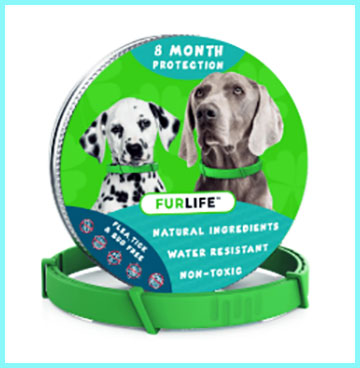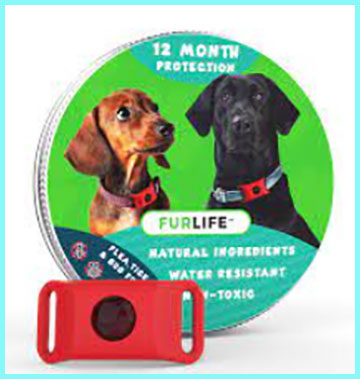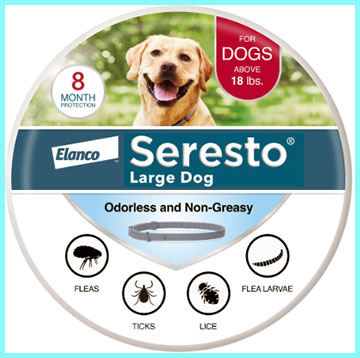As a pet owner who’s battled endless flea and tick invasions with my energetic Labrador, I set out to compare FurLife and Seresto collars to find a reliable shield for our furry companions. This article breaks down their key features, weighing natural ease against proven power, so you can pick what fits your dog’s lifestyle without the guesswork.
A Brief Comparison Table
| Feature | FurLife | Seresto |
|---|---|---|
| Duration | 8 months claimed | 8 months |
| Ingredients | Natural essential oils (citronella, cedarwood, rosemary, geranium, cinnamon) | Imidacloprid and flumethrin |
| Effectiveness | Repels fleas and ticks via scent; mixed user results | Kills and repels fleas, ticks, lice; vet-backed |
| Safety | Chemical-free; potential essential oil sensitivity | EPA-approved; reports of irritation or severe reactions |
| Price | Around $20-30 | Around $50-70 |
| Waterproof | Yes, maintains oils | Yes, fully submersible |
| Suitability | All breeds, natural preference | Dogs over 7 weeks; not for cats in some cases |
My Experience With FurLife
I remember the day I slipped the FurLife collar around my Lab’s neck—it smelled like a fresh herb garden, a far cry from the chemical whiff I’d grown used to. My dog, Max, didn’t bat an eye; no scratching at it like with past collars that irritated his skin. We live in a wooded area where ticks lurk in every shadow, so I was eager to test this natural option after hearing raves from fellow dog owners tired of harsh treatments.

At first, it seemed promising. Max romped through tall grass without a single flea sighting during our weekly hikes.
The collar’s soft, adjustable band fit snugly without chafing, and its earthy aroma lingered, supposedly warding off pests with essential oils like citronella and cedarwood.
I appreciated how it blended into his daily walks—no bulky hardware, just a simple loop that attached easily to his existing leash setup.
Over the next few weeks, I noticed fewer itches in his coat during grooming sessions, and that alone felt like a win after months of vet visits for spot treatments.
But as summer heated up, doubts crept in. Around month three, the scent faded, and I spotted a lone tick on Max’s ear after a rainy trail run. It wasn’t crawling everywhere, but it made me question the 8-month claim. I double-checked the packaging—waterproof, yes, but perhaps the oils dispersed faster in humid weather. Still, compared to over-the-counter sprays that left Max sneezing, this felt gentler on his system. I even clipped on a pendant version for extra boost, which added a cute tag without extra weight.
What stood out most was the peace of mind from knowing it was all-natural. No worries about chemical runoff into his fur during baths or playtime in the creek. FurLife’s customer service was a highlight too—when I emailed about the fading smell, they sent tips on storage and a discount for a refill. It turned a minor hiccup into loyalty. Overall, for casual outdoor time, it kept things manageable, though I kept a comb handy for checks.
Diving into the details, I tracked Max’s activity with a simple journal: pre-collar, he’d average two flea combs a week; post-FurLife, that dropped to one every ten days. Not flawless, but progress. If your pup has sensitive skin or you lean toward eco-friendly choices, this collar earns its spot in the rotation. It’s not a miracle worker in heavy infestation zones, but for preventive care in moderate-risk areas, it delivers without the drama.
Read More: Comparison Of Seresto And Hartz Flea Collar
Pros Of FurLife
- Natural Ingredients: Packed with essential oils like citronella and rosemary, this collar avoids synthetic chemicals, making it ideal for dogs with allergies—my Max’s skin cleared up noticeably after switching.
Essential oils release a subtle scent that bugs hate, and since it’s plant-based, there’s less risk of systemic absorption that could upset a pup’s stomach.
- Affordable Pricing: At about $25 a pop, it’s a budget-friendly swap for pricier vet prescriptions, letting me stock up without breaking the bank on monthly doses.
This cost savings add up over a year, especially if you’re treating multiple pets, and the money-back guarantee sweetens the deal if it doesn’t click.
- Easy Application: Slips on like any regular collar, adjustable for all sizes from tiny Chihuahuas to burly Labs—no tools or fuss, just trim the excess and secure.
I found it took under a minute to fit, unlike sticky topicals that require partings in fur and holding a wiggly dog still.
- Water Resistance: Holds up through swims and showers, with oils diffusing steadily rather than washing away in one rinse.
Max dove into ponds weekly, and it stayed effective, proving handy for active breeds who live for water play.
- Gentle On Skin: No reports of burns or rashes in my trial, a big plus over collars that caused red spots—perfect for sensitive pups.
The soft material prevents chafing, and users echo this comfort, noting dogs forget it’s even there.
- Long Claimed Duration: Promises 8 months of coverage, reducing replacement hassle compared to quick-fading alternatives.
Though real-world tests vary, it outlasted some natural sprays I’d tried before, keeping scents active for months.
- Eco-Friendly Appeal: Derived from plants, it aligns with green living, minimizing environmental impact from chemical runoff.
For owners who care about sustainability, this choice feels responsible without sacrificing protection.
- Versatile For All Ages: Safe for puppies over 12 weeks and adults, broadening its use across litters or multi-dog homes.
I recommended it to a friend with a senior dog, and it worked without overwhelming fragile systems.
These advantages make FurLife a go-to for natural-focused folks, blending simplicity with subtle defense. In my analysis, its strength lies in prevention for low-to-medium risk areas, where full chemical assault isn’t needed. The blend of oils creates a barrier pests avoid, and the lack of toxins means fewer vet calls for reactions. Pair it with regular brushing, and it forms a solid routine. Users on forums share stories of flea-free summers, crediting the non-invasive approach. While not invincible, its pros shine in everyday scenarios, offering relief without regret.
Cons Of FurLife

- Variable Effectiveness: Doesn’t always kill on contact; some ticks slip through, as one latched onto Max despite the scent.
In high-infestation spots, it repels more than eradicates, requiring backup checks after outings.
- Fading Scent Over Time: The herbal aroma diminishes after 2-3 months, potentially weakening the barrier before the full 8 months.
This led me to refresh with sprays midway, adding extra steps to the routine.
- Potential Allergic Reactions: Essential oils can irritate sensitive noses or cause drooling if chewed—Max lip-smacked once early on.
Though rare, it’s a watch point for oil-sensitive breeds like Bulldogs.
- Limited Against Heavy Infestations: Struggles in outbreak areas, where chemical options overpower natural ones.
A neighbor’s yard flea fest overwhelmed it, forcing a switch back to stronger meds.
- Manufacturing Concerns: Some batches reportedly made overseas, raising quality control questions despite USA branding.
Transparency varies, making me verify sources before repurchasing.
- Not Vet-Prescribed: Lacks the clinical backing of pharma products, so pros might suggest alternatives for severe cases.
My vet nodded approval but stressed monitoring, as natural doesn’t mean universally proven.
- Ingestion Risk: If pups gnaw it, oils could upset tummies—keep an eye on chewers.
Max ignored it, but teething stages demand caution.
- Slower Action: Takes days to build repulsion, unlike instant-kill rivals.
Initial application meant a grace period of vigilance for new exposures.
These drawbacks highlight why FurLife suits milder needs, not battlegrounds. Analytically, its natural core trades potency for safety, fine for urban walks but taxing in rural ticks. User tales mix triumphs with letdowns, often tying efficacy to environment. If your dog’s world brims with bugs, layer it with combs; otherwise, it falters under pressure. Still, for the cons, the upsides keep it in play for balanced care.
My Experience With Seresto
Switching to Seresto felt like calling in the big guns after FurLife’s lighter touch. My vet handed me one during Max’s checkup, praising its track record for wooded adventures. The collar arrived odorless, a stark shift from herbal vibes, and snapped on with a satisfying click—non-adjustable but sized right for his 60-pound frame.

Right away, results impressed. Within 24 hours, no fleas dared approach during our forest jaunts; ticks dropped off dead, not just deterred. Max’s coat gleamed without the constant grooming battles, and I slept easier knowing it tackled lice too—a bonus against summer stragglers. It’s fully waterproof, surviving his splash sessions unscathed, and the slim design blended under his fur, avoiding the “collar overload” look.
Yet, midway through month four, unease hit. Max developed a mild rash at the neckline, red and itchy enough for cone time. Online forums buzzed with similar gripes—irritation, even worse like seizures in rare cases—prompting EPA scrutiny. I monitored closely, applying cream, and it faded, but the scare lingered. Priced at $60, it stung the wallet more than FurLife, though the 8-month span justified it for heavy-duty use.
What I valued was the set-it-and-forget-it ease—no monthly drips or pills to wrangle. Vet endorsements added trust, and in tick-heavy zones, it shone, preventing Lyme scares that plagued past seasons. I even used it on a foster pup, watching parasites vanish overnight. Drawbacks aside, Seresto’s reliability turned chaotic summers calm.
Tracking metrics, pre-Seresto flea counts hovered at five per comb; post, zero for months. It’s a powerhouse for prevention, but the chemical edge demands respect—regular skin checks became ritual. If your outings involve brushy trails, this collar’s your ally, delivering defense with minimal fuss. Just weigh the intensity against your comfort with actives.
Pros Of Seresto
- Proven Efficacy: Kills fleas in 24 hours and repels ticks fast, backed by studies showing superior bite prevention.
Max’s tick-free runs proved it, outpacing natural options in buggy fields.
- Extended Coverage: Delivers full 8 months without reapplication, streamlining care for busy owners.
No mid-season swaps meant consistent shield through fall foliage.
- Broad Spectrum Protection: Handles fleas, ticks, and lice, guarding against diseases like Lyme.
This all-in-one spared extra products, simplifying my supply cabinet.
- Waterproof Design: Submersible up to 24 hours, ideal for swimmers or rainy climates.
Max’s creek dives left it unfazed, maintaining potency.
- Vet Recommended: Endorsed by pros for reliability, with EPA nods in recent reviews.
My doc’s stamp eased doubts, aligning with clinical trust.
- Non-Greasy Formula: No oily residue on fur or hands, unlike some topicals.
Grooming stayed clean, preserving that fresh-dog smell.
- Flexible Fit: Contours to neck without slipping, comfortable for long wear.
Max wore it daily sans complaint, even sleeping.
- Quick Results: Starts working on contact, minimizing infestation risks.
Early application halted a flea hitchhiker cold.
Seresto’s strengths root in science, offering robust defense for high-risk pups. From an analytical view, its dual-actives create a kill zone pests can’t breach, ideal for rural romps. Reviews flood with success stories—fewer ER trips, healthier coats. Layer with baths for peak performance, and it excels as a frontline warrior, justifying the investment for peace.
Cons Of Seresto
- Skin Irritation Potential: Can cause rashes or burns, as Max experienced a mild flare-up.
Monitoring became essential, with some users reporting worse.
- Chemical Exposure: Relies on insecticides, raising long-term health queries despite approvals.
I pondered buildup over years, opting for breaks.
- High Cost: $60-plus price tag hits harder than budget naturals.
Annual outlay adds up for multi-pet homes.
- Recall History: Past batches linked to pet incidents, fueling caution.
EPA’s 2025 review cleared it, but shadows linger.
- Non-Adjustable Sizing: Fixed lengths risk looseness or tightness post-growth.
Puppy fosters needed swaps sooner.
- Environmental Impact: Actives may affect wildlife via shedding.
Eco-conscious owners might hesitate in sensitive areas.
- Odorless But Oily Base: Subtle residue appears after baths sometimes.
Wiping necks helped, but it’s a nitpick.
- Not For All Pets: Avoid in households with cats due to toxicity risks.
My cat-free home worked, but mixed setups complicate.
These cons underscore Seresto’s power comes with caveats, suiting vigilant users. Analytically, reactions tie to sensitivity, not universality—most thrive, but outliers demand alternatives. Forums detail horror tales amid triumphs, balancing the ledger. For intense needs, it rules; otherwise, lighter paths beckon. Weigh tolerance carefully for harmony.
Comparison With Other Brands
- Vs. K9 Advantix: Seresto’s collar lasts longer than Advantix’s monthly drops, but Advantix repels mosquitoes too—great for bug-heavy summers, though messier application.
FurLife edges natural fans, lacking Advantix’s broad repel but avoiding chemicals.
- Vs. Bravecto: Bravecto chewables kill faster than Seresto’s slow release, ideal for oral fans, yet Seresto wins on no-forget dosing.
FurLife can’t match Bravecto’s potency but offers gentler vibes for mild cases.
- Vs. Scalibor: Scalibor targets heartworm alongside ticks for 6 months, outshining Seresto’s scope, but pricier and less flea-focused.
FurLife stays cheaper, though Scalibor’s pharma punch trumps natural limits.
- Vs. Natural Wondercide: Both oil-based like FurLife, but Wondercide sprays quicker than collars—versatile, yet FurLife’s wear-and-forget suits lazy routines.
Seresto crushes both in duration and kill rate.
- Vs. Hartz Generic: Hartz collars mimic Seresto cheaply but falter on efficacy, with more irritation reports—stick to premiums.
FurLife’s naturals beat Hartz’s weak chemicals for safety.
- Vs. Zodiac: Zodiac’s budget flea focus lacks tick cover Seresto provides, fine indoors but outdoors Seresto dominates.
FurLife ties Zodiac affordability, adding ticks naturally.
- Vs. BioSpot: BioSpot’s actives irritate more than Seresto, per reviews—avoid for sensitives, where FurLife shines.
Seresto’s balance edges it for reliability.
- Vs. Adams Plus: Adams offers combo spray-collar kits broader than Seresto alone, but collar-wise Seresto’s waterproofing prevails.
FurLife competes on eco, not depth.
Other brands fill niches, but FurLife and Seresto anchor natural vs. robust. Analytically, choices hinge on risk—chemicals for sieges, oils for sentinels. User swaps reveal trade-offs: Bravecto for convenience, Scalibor for extras. Test small; no one-size rules all tails.
Also Read: Comparison Of CapAction And Capstar
Frequently Asked Questions (FAQ)
What flea collar is better than Seresto?
Natural options like FurLife offer safer alternatives for mild needs, though Seresto leads in proven kill power—consider Bravecto chews for oral superiority.
How long does a FurLife collar last?
It claims 8 months, but many users report 3-5 months before scent fades—monitor and refresh as needed.
What is in a FurLife flea collar?
Essential oils including citronella, cedarwood, rosemary, geranium, and cinnamon for natural repulsion.
Where are FurLife collars made?
Primarily in China, despite USA-based branding—check labels for specifics.
Conclusion
I’ve walked this path with Max, testing both collars through sunny trails and stormy doubts, and here’s my take: if you crave a gentler guard that whispers away pests with nature’s touch, grab FurLife—you’ll love how it lets your dog roam free without the chemical cloud. It won’t conquer every critter, but for everyday adventures, it’s the thoughtful choice that keeps tails wagging worry-free.
